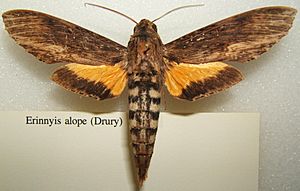Alope sphinx facts for kids
Quick facts for kids Alope sphinx |
|
|---|---|
 |
|
| Erinnyis alope, adult | |
| Scientific classification | |
| Genus: |
Erinnyis
|
| Species: |
alope
|
| Synonyms | |
|
|
The Alope sphinx (scientific name: Erinnyis alope) is a fascinating type of moth. It belongs to the Sphingidae family, which are often called sphinx moths or hawk-moths. These moths are known for their strong, fast flight. You can find the Alope sphinx moth in many warm places. It lives from northern South America, through Central America, and up to northern Mexico. It also lives in the very southern parts of the United States. Sometimes, these moths even fly as far north as Arkansas and Kansas!
What Does the Alope Sphinx Moth Look Like?
The Alope sphinx moth is quite large. Its wingspan (the distance from one wingtip to the other) is usually between 82 and 100 millimeters. That's about the length of a credit card!
The top side of its front wings is dark brown. It has short yellowish lines near the front edge. It also has wavy yellowish bands closer to the back. The top side of its back wings is bright yellow. These yellow wings have a wide, dark brown border. The moth's body is smooth and has a checkered pattern.
Where Do Alope Sphinx Moths Live?
Alope sphinx moths can be found in many different places. They live in warm areas like northern Argentina and Uruguay. From there, they spread north through Central America and Mexico. They also live in the West Indies. In the United States, you can find them in southern Florida, southern Texas, southern New Mexico, and southern Arizona.
There is also a special group of these moths. They live on the Galapagos Islands. This group is known as Erinnyis alope dispersa.
What Do Alope Sphinx Moths Eat?
Adult Alope sphinx moths are active all year in tropical areas. They are also active year-round in southern Florida. These moths fly around and drink nectar from different flowers. One flower they like is called Asystasia gangetica.
The young moths, called larvae (or caterpillars), eat leaves from certain plants. They enjoy eating Papaya (Carica papaya). They also munch on Cassava (Manihot esculenta). Other plants they eat include Nettlespurge (Jatropha) and Allamanda (Allamanda).

